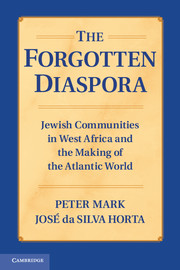Book contents
- Frontmatter
- Contents
- List of Illustrations
- Acknowledgments
- Introduction
- 1 Two Sephardic Communities on Senegal's Petite Côte
- 2 Jewish Identity in Senegambia
- 3 Religious Interaction
- 4 The Blade Weapons Trade in Seventeenth-Century West Africa
- 5 The Luso-African Ivories as Historical Source for the Weapons Trade and for the Jewish Presence in Guinea of Cape Verde
- 6 The Later Years
- Conclusion
- Appendix I The Jewish Traders of Porto d'Ale and Joal, Their Relatives, and Some of Their New Christian Partners in Senegambia and in the United Provinces and Portugal: A Comprehensive List (ca. 1606–ca. 1635)
- Appendix II A Chronological Outline of the Institutional Proceedings against the Jews of Porto d'Ale and Joal (1611–1643)
- Bibliography
- Index
4 - The Blade Weapons Trade in Seventeenth-Century West Africa
Published online by Cambridge University Press: 03 May 2011
- Frontmatter
- Contents
- List of Illustrations
- Acknowledgments
- Introduction
- 1 Two Sephardic Communities on Senegal's Petite Côte
- 2 Jewish Identity in Senegambia
- 3 Religious Interaction
- 4 The Blade Weapons Trade in Seventeenth-Century West Africa
- 5 The Luso-African Ivories as Historical Source for the Weapons Trade and for the Jewish Presence in Guinea of Cape Verde
- 6 The Later Years
- Conclusion
- Appendix I The Jewish Traders of Porto d'Ale and Joal, Their Relatives, and Some of Their New Christian Partners in Senegambia and in the United Provinces and Portugal: A Comprehensive List (ca. 1606–ca. 1635)
- Appendix II A Chronological Outline of the Institutional Proceedings against the Jews of Porto d'Ale and Joal (1611–1643)
- Bibliography
- Index
Summary
Recently discovered archival sources of the Lisbon Inquisition document the production of blade weapons, or armas brancas, by Lisbon-based artisans, working with traders who contracted for the swords. Many of these contractors were New Christians, during a thirty-year period from 1590 to 1618. The weapons were transported to the Rivers of Guinea, where they were traded to African elites. After 1608, the Jewish merchants who had settled on the Petite Côte became important players in this coastal commerce. In West Africa, the weapons were exchanged for slaves and other goods. This commerce in swords and daggers contravened a Papal Bull that prohibited Christians from trading weapons to non-Christians. The commerce, largely ignored by historians, is corroborated by Portuguese travel narratives from the period. However, the weapons trade actually had its origins in the mid-fifteenth century, with the arrival of the Portuguese on the Atlantic coast of West Africa.
Both the production and the military use of “armas brancas” – the name refers to the white tinge of steel-bladed hand weapons – was highly developed in Portugal. These specialized arms came in many different forms. Espadas were double-edged, full-length swords that were wielded in the right hand. The more readily handled terçados mentioned earlier, were ideal for cavalry use. Short arms took the form of adagas, with a broad, short, and pointed blade, generally with two cutting edges; and punhais, with narrower and smaller blades. The adaga, corresponding more closely to the English “dagger,” was wielded in the left hand.
- Type
- Chapter
- Information
- The Forgotten DiasporaJewish Communities in West Africa and the Making of the Atlantic World, pp. 103 - 134Publisher: Cambridge University PressPrint publication year: 2011



